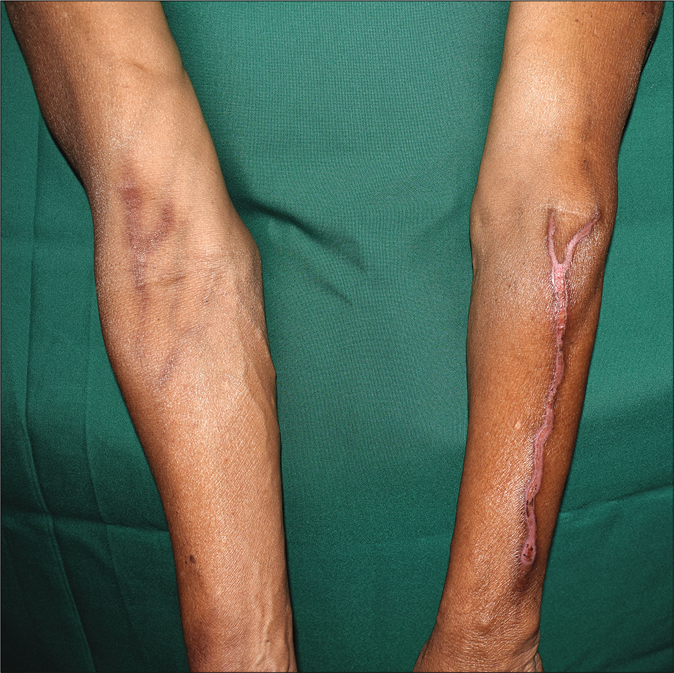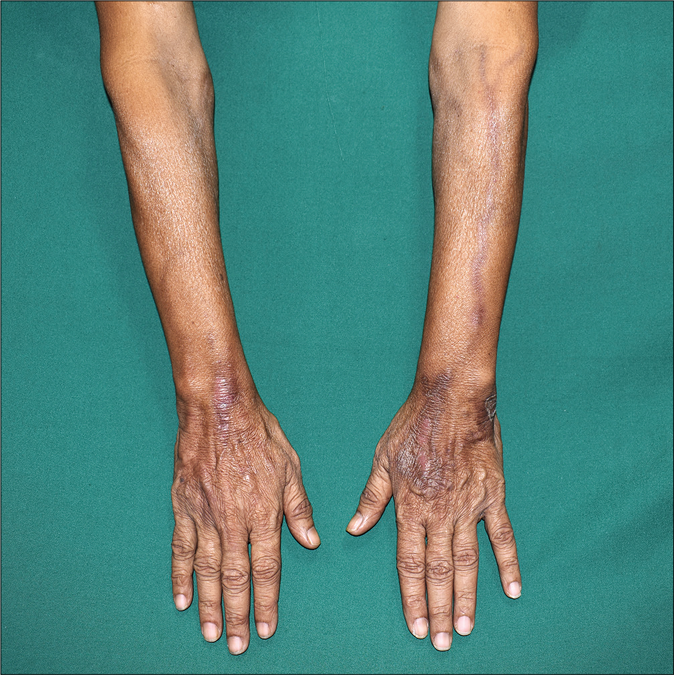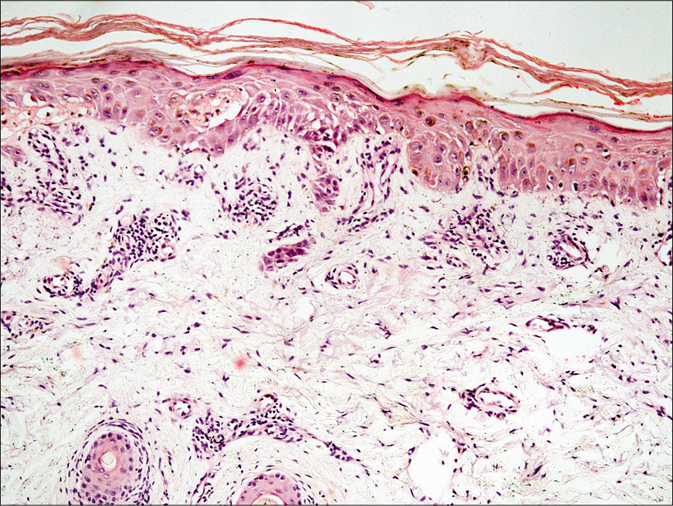Translate this page into:
An unusual case of recurrent chemotherapy recall phenomenon
Corresponding author: Dr. Vishal Gupta, Department of Dermatology and Venereology, All India Institute of Medical Sciences, Ansari Nagar, New Delhi - 110 029, India. doctor.vishalgupta@gmail.com
-
Received: ,
Accepted: ,
How to cite this article: Taneja N, Agarwal S, Gupta V. An unusual case of recurrent chemotherapy recall phenomenon. Indian J Dermatol Venereol Leprol 2021;87:263-5.
Sir,
Mucocutaneous adverse effects of chemotherapy are largely well-recognized; however, chemotherapy recall has been rarely reported in literature.
A 55-year-old man with a medical history of relapsed colonic adenocarcinoma was being treated with 2-weekly cycles of irinotecan (300 mg on day 1) and 5-fluorouracil (680 mg bolus on day 1, followed by 400 mg infusion over 2 days). He presented to us with a 5-day history of pain and blisters over the left forearm in a linear pattern following the third chemotherapy cycle. This chemotherapy cycle had been administered through a superficial vein on the contralateral antecubital fossa. However, the lesions had developed over his left forearm, through which he had received the previous chemotherapy cycle 2 weeks ago. There was no prior history suggestive of a drug extravasation reaction at this site. On examination, there was a thin hypopigmented supravenous linear plaque with superficial ulceration over the left forearm and hyperpigmentation over the right cubital fossa [Figure 1]. The lesions resolved with a topical corticosteroid–antibiotic combination in a few days. The patient consulted us again after the fifth chemotherapy cycle, for burning pain and dusky erythema over the dorsa of both hands along the veins used for the previous (fourth) chemotherapy administration [Figure 2]. The fifth chemotherapy cycle was given through a vein on dorsum of the right hand, but distant from the site of current symptoms. At this time, a skin biopsy from erythema on the dorsum of the left hand was performed, which showed focal parakeratosis with neutrophils in the stratum corneum, spongiosis, a few necrotic keratinocytes and focal basal epidermal vacuolar damage. There was a mild interstitial infiltrate of lymphocytes and histiocytes in the superficial dermis [Figure 3]. The skin lesions subsided within 3 to 4 days with a potent topical corticosteroid. The patient developed similar symptoms after the sixth cycle as well, at the site through which he received his fifth chemotherapy administration, which resolved with topical corticosteroids in a few days. The chronological sequence of the patient’s symptoms and chemotherapy cycles is summarized in Table 1.

- Linear hypopigmented plaque with superficial ulcers along the course of vein on left forearm (chemotherapy administered through a vein on contralateral right cubital fossa). Note the supraventine hyperpigmentation on the right cubital fossa, probably representing postinflammatory sequelae of an earlier chemotherapy recall reaction

- Bilateral dorsa of the hands showing dusky erythema and scaling over the veins through which the patient received his previous chemotherapy cycle. Note the previous recall reaction on the left forearm has subsided with hyperpigmentation
| Chemotherapy session | Veins used for chemotherapy administration | Sites developing recall reaction |
|---|---|---|
| Second | Vein of the left forearm | Cannot recall the exact events |
| Third* | Right antecubital fossa | Along the vein on the left forearm |
| Fourth | Dorsum of bilateral hands | Along the vein right antecubital fossa |
| Fifth* | Dorsum of the right hand | Along the veins on the dorsum of both hands |
| Sixth* | Vein on the right forearm | Along the vein on the dorsum of the right hand |

- Skin biopsy showed focal parakeratosis, mild spongiosis and a few necrotic keratinocytes in the epidermis (H and E, ×100)

- Higher magnification showing mild spongiosis, necrotic keratinocytes and focal vacuolar basal keratinocyte damage (H and E, ×400)
The recall phenomenon is best known with radiation therapy, manifesting as “recall” of dermatitis by the skin in a previously irradiated field. It presents as an acute inflammatory reaction, similar to a ‘sunburn,’ confined to the site of prior irradiation, which is triggered by certain anticancer medications and antibiotics.1 Rarely, such a recall phenomenon may also occur at sites of previous intravenous chemotherapy administration.2,3
Our patient developed inflammatory reactions after each chemotherapy cycle, along the course of the superficial vein used for the antecedent chemotherapy administration. Interestingly, the “recall” happened only along the veins used for the last cycle, while the other former sites of chemotherapy administration remained quiescent. While 5-fluorouracil has been previously reported to cause chemotherapy recall reactions, we could not find any similar reports with irinotecan.2 Apart from 5-fluorouracil, chemotherapy recall reactions have also been reported with mitomycin C, paclitaxel, doxorubicin and epirubicin.3 A history of drug extravasation reaction was usually present in these cases before the recall phenomenon, and the recall reaction occurred only at the site of extravasation reaction.2,4,5 However, our patient denied history suggestive of any prior drug extravasation reaction. Recall reaction without a preceding history of drug extravasation has also been reported previously with 5-fluorouracil administration.3 Unlike our case, the recall manifested as tender nodules and only at the sites of intravenous access for previous chemotherapy cycles. The authors did not mention if the recall was confined to sites of only the immediately preceding chemotherapy infusions or all previous sites of chemotherapy administration.3 The exact pathogenesis of this phenomenon is not known. It has been postulated that the relatively high local concentrations of the chemotherapeutic drug during the initial infusions may cause subclinical tissue damage, which becomes more severe and manifests clinically when re-exposed to the drug via systemic circulation.3 To conclude, we report an unusual case of recurrent chemotherapy recall reactions. Topical corticosteroids improved the recall reactions and chemotherapy could be continued without any interruption or dose reduction.
Declaration of patient consent
The authors certify that they have obtained all appropriate patient consent.
Financial support and sponsorship
Nil.
Conflicts of interest
There are no conflicts of interest.
References
- Letter: Adriamycin activating a recall phenomenon after radiation therapy. Ann Intern Med. 1974;81:407-8.
- [CrossRef] [PubMed] [Google Scholar]
- Recall of cutaneous toxicity from fluorouracil. Arch Dermatol. 1993;129:644-5.
- [CrossRef] [PubMed] [Google Scholar]
- Chemotherapy recall reactions. J Am Acad Dermatol. 2002;46:797.
- [CrossRef] [PubMed] [Google Scholar]
- Recall phenomenon following epirubicin. Clin Oncol (R Coll Radiol). 1999;11:424-5.
- [CrossRef] [PubMed] [Google Scholar]
- Paclitaxel-induced “recall” soft tissue injury occurring at the site of previous extravasation with subsequent intravenous treatment in a different limb. J Clin Oncol. 1994;12:2237-8.
- [CrossRef] [PubMed] [Google Scholar]





